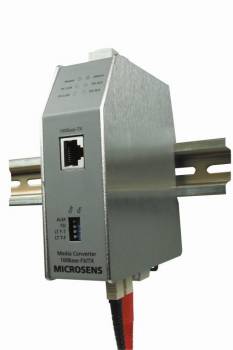MICROSENS MS650420 - Ethernet/Fast Ethernet Media Converter in industrial design
Networks > Media-Converters

MICROSENS MS650420 - Ethernet/Fast Ethernet Media Converter in industrial design
| Lieske Part No. | 952602 |
|---|---|
| Mfg Part No | MS650420 |
| EAN-Code | |
| Manufacturer | MICROSENS |
| Here only | 402,27 EUR
478,70 EUR incl. VAT
|
Further information for MICROSENS MS650420 - Ethernet/Fast Ethernet Media Converter in industrial design
Robust media converter for Fast Ethernet (100 Mbps) and Ethernet (10 Mbps)
Transparent conversion of the data
External alarm contacts
Connection for redundant power supply
Effective overvoltage protection
In addition to being deployed in local networks, Ethernet is spreading increasingly across production environments. Modern machine control systems and industrial plants are already equipped with 10/100Base-TX interfaces.
Production environments can also benefit from flexible media conversion by employing fibre optics as they are insensitive against electromagnetic interference and do not suffer from galvanic separation, enable longer transmission distances, and are highly reliable. However, deployment of fibre optics for such as active hubs, switches, and media converters in office environments is fundamentally different from the deployment in production environments where fast initialisation, high robustness and availability, as well as fail safe operation are required. For this extremely demanding environment, MICROSENS has developed special media converters in industrial designs.
The existing product range of Ethernet (10Base-FL/10Base-T) and Fast Ethernet (100Base-FX/100Base-TX) media converters has been complemented with new media converters for serial interfaces in production environments and RS-232/V.24, RS-422/V.11 and RS-485 copper/fibre optics converters.
An integrated mounting device allows the direct installation on 35mm hat rails.
The components are driven by a 24V DC power supply. A second mains terminal can be used for redundant power supply. The Ethernet converters have a switch for reversing the port input of the RJ-45 connector. Therefore, the 100Base-TX copper connection can be carried out via common 1:1 patch cables. In addition to the SUBD-9 connection, the serial converters also have parallel terminals for flexible bus installation. Floating contacts are another option. Messaging systems can be connected via special terminals in order to indicate connection failures and trigger certain actions.
The fibre optic connector is located on the underside of the device. This ensures protection of the optical transceiver against dust and contamination.
Transparent conversion of the data
External alarm contacts
Connection for redundant power supply
Effective overvoltage protection
In addition to being deployed in local networks, Ethernet is spreading increasingly across production environments. Modern machine control systems and industrial plants are already equipped with 10/100Base-TX interfaces.
Production environments can also benefit from flexible media conversion by employing fibre optics as they are insensitive against electromagnetic interference and do not suffer from galvanic separation, enable longer transmission distances, and are highly reliable. However, deployment of fibre optics for such as active hubs, switches, and media converters in office environments is fundamentally different from the deployment in production environments where fast initialisation, high robustness and availability, as well as fail safe operation are required. For this extremely demanding environment, MICROSENS has developed special media converters in industrial designs.
The existing product range of Ethernet (10Base-FL/10Base-T) and Fast Ethernet (100Base-FX/100Base-TX) media converters has been complemented with new media converters for serial interfaces in production environments and RS-232/V.24, RS-422/V.11 and RS-485 copper/fibre optics converters.
An integrated mounting device allows the direct installation on 35mm hat rails.
The components are driven by a 24V DC power supply. A second mains terminal can be used for redundant power supply. The Ethernet converters have a switch for reversing the port input of the RJ-45 connector. Therefore, the 100Base-TX copper connection can be carried out via common 1:1 patch cables. In addition to the SUBD-9 connection, the serial converters also have parallel terminals for flexible bus installation. Floating contacts are another option. Messaging systems can be connected via special terminals in order to indicate connection failures and trigger certain actions.
The fibre optic connector is located on the underside of the device. This ensures protection of the optical transceiver against dust and contamination.

This is an offer of:
79279 Vörstetten
http://industry-electronics.com
Tel. 07666/88499-0
Fax. 07666/88499-111
Diesen Artikel finden Sie unter:
industry-electronics.com/artikel/952602

Lieske Elektronik e.K.
Reutener Str. 1079279 Vörstetten
http://industry-electronics.com
Tel. 07666/88499-0
Fax. 07666/88499-111
Diesen Artikel finden Sie unter:
industry-electronics.com/artikel/952602
